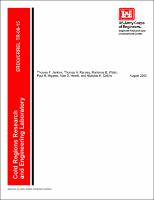Please use this identifier to cite or link to this item:
https://hdl.handle.net/11681/5571| Title: | Evaluating the use of snow-covered ranges to estimate the explosives residues that result from detonation of army munitions |
| Authors: | Jenkins, Thomas F. Ranney, Thomas A. Walsh, Marianne E. Miyares, Paul H. Hewitt, Alan D. (Alan Dole) Collins, Nicholas H. |
| Keywords: | Explosives, Military Snow |
| Publisher: | Cold Regions Research and Engineering Laboratory (U.S.) Engineer Research and Development Center (U.S.) |
| Series/Report no.: | ERDC/CRREL ; TR-00-15. |
| Abstract: | Estimating the amounts of residues remaining after munitions detonate is complicated by the presence of residues from previous detonations and the difficulty in easily obtaining adequately sized samples to overcome spatial heterogeneity in residue deposition. This study was conducted to assess the use of snow-covered ranges to provide these types of estimates. Specifically, two snow-covered ranges were used to estimate the amount of explosives residues that result from detonation of individual mortar rounds. At Fort Drum, New York, 60-mm mortar rounds were fired, and at Camp Ethan Allen, Vermont, 81-mm mortar rounds were detonated by EOD personnel using C4 (RDX) and a blasting cap. The locations where residues were deposited were identified by the presence of soot from the detonation of TNT on the surface of the otherwise clean snow. Large surface snow samples were collected with a snow shovel and the melted snow was extracted and analyzed by gas chromatography with an electron capture detector (GC-ECD) and reversed-phase high performance liquid chromatography (RP-HPLC). For both types of rounds, the main charge was Composition B (60% RDX and 39% TNT). The major residues produced were RDX and nitroglycerine (NG), with lesser amounts of HMX and TNT. Surface concentrations ranged from as high as 4430 µg/m² for RDX to less than 0.05 µg/m² for TNT, both at Camp Ethan Allen. The major advantages of using snow-covered ranges were: 1) the snow cover provided an uncontaminated surface, unaffected by previous detonations, 2) the black soot produced from the detonation of TNT delineated the areas where residue had deposited and 3) surface snow provides both a convenient matrix for collection of large surface area samples, essential for characterizing heterogeneously distributed residues, and a matrix free from interferences. |
| URI: | http://hdl.handle.net/11681/5571 |
| Appears in Collections: | Technical Report |
Files in This Item:
| File | Description | Size | Format | |
|---|---|---|---|---|
| ERDC-CRREL-TR-00-15.pdf | 438.25 kB | Adobe PDF |  View/Open |